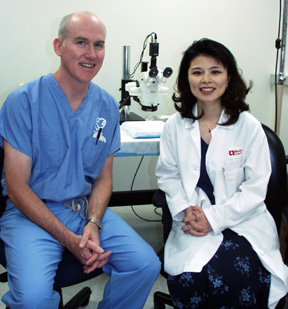 |
Timothy Baxter, M.D., left, and Wanfen Xiong, M.D., Ph.D. |
An aortic aneurysm is a bulge in the aorta, which may burst from the weakening of vessel walls. Currently, the only way to treat aortic aneurysms is by surgical intervention. Timothy Baxter, M.D., and Wanfen Xiong, M.D., Ph.D., however, are looking at ways to detect aneurysms earlier and treat them with drugs before surgical repair is necessary.
“The grant will look at factors that cause aneurysms,” Dr. Baxter said. “Our goal is to develop treatments for small aneurysms, as well as markers to identify them. Doing that would lower the anxiety levels of patients with small, but growing aneurysms and improve the medical outcomes of this common and potentially deadly disease.”
“Dr. Baxter is a great example of an outstanding surgeon who also does world-class research that is directly related to improved health outcomes,” said Thomas Rosenquist, Ph.D., vice chancellor for research at UNMC. “Winning this large grant in the highly competitive NIH funding arena is proof of the esteem with which Dr. Baxter’s colleagues view his work.”
Aortic aneurysms, which occur in about 2 percent of the population, often are asymptomatic and go undiagnosed until they rupture. Mathematician Albert Einstein, comedian Lucille Ball and actor George C. Scott all died of ruptured aneurysms.
Aortic aneurysms can be detected through ultrasound screenings, which men should begin at age 65. Presently, most aneurysms are found when X-rays are done for an unrelated problem. If detected early, large aneurysms can be safely repaired with elective surgery. Small aneurysms, on the other hand, are observed for growth with repair being reserved for those that grow rapidly or reach a dangerously large size. About 90 percent of patients die from bleeding once the aneurysm ruptures, Dr. Baxter said.
The risk of rupture increases once the aneurysm grows larger than 5 centimeters, Dr. Baxter said, so aneurysms less than 5 centimeters are monitored every six months via an ultrasound. “Most aneurysms grow over time so there’s a lot of anxiety associated with them,” he said.
Aneurysms are most commonly found in men (the average age is 70), but 20 percent of patients treated for aneurysms are women. Smoking, a family history of aneurysms and high blood pressure are contributing factors.
Dr. Baxter’s team also is studying the effectiveness of a common antibiotic, doxycycline, in slowing or stopping the growth of aneurysms. “It has been quite effective in mouse models,” Dr. Baxter said.
A consortium of researchers led by Dr. Baxter are working with the National Institute on Aging to develop a clinical trial to test the doxycycline pill, which blocks enzymes that break down tissue and cause aneurysms to grow. The multi-centered trial could begin as early as 2006, Dr. Baxter said.
Despite new and less-invasive treatment options for large aneurysms, Dr. Baxter said, patients with small aneurysms would prefer a medical treatment that could prevent aneurysm growth so that surgery would never be necessary.